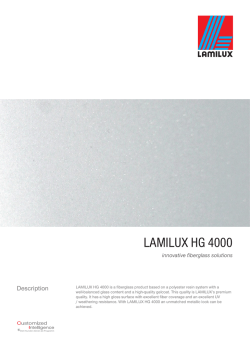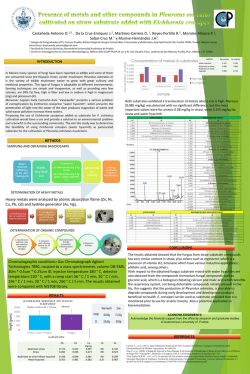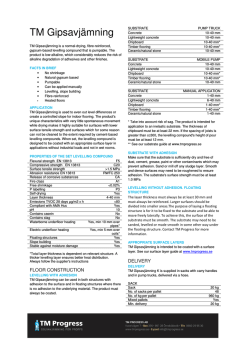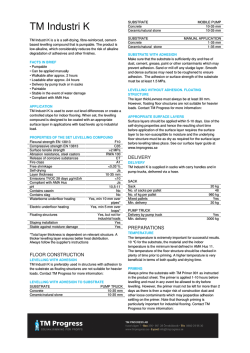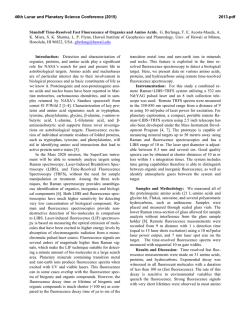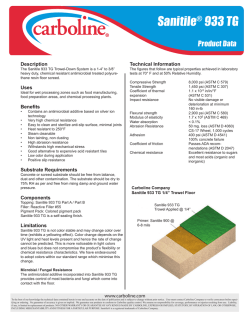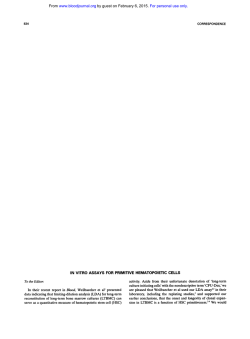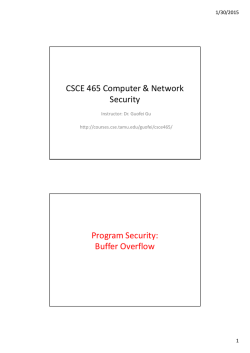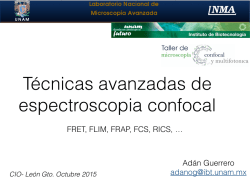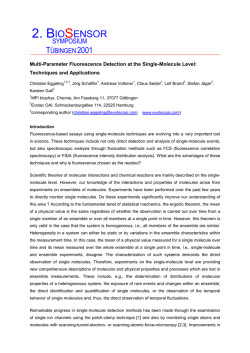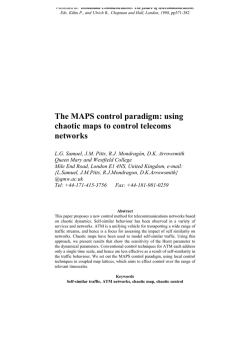
SensoLyte AFC Caspase Sampler Kit *Fluorimetric*
SensoLyte® AFC Caspase Sampler Kit *Fluorimetric* Catalog # 71117 Kit Size 8 X 100 Assays Convenient Format: Mix-and-read one-step homogeneous assay. Optimized Performance: Optimal conditions for assaying the activity of caspase. Enhanced Value: Less expensive than the sum of individual components. High Speed: Minimal hands-on time. Assured Reliability: Detailed protocol and references are provided. ______________________________________________________________________________ Kit Components, Storage and Handling Component Component A Component B Description Caspase substrates Peptide sequence: Appendix I, Table 1 Ex/Em=380 nm/500 nm upon cleavage AFC, fluorescence reference standard Ex/Em=380 nm/500 nm Quantity 8 substrates 10 mM, 70 μL 10 mM, 20 μL Component C Assay buffer 80 mL Component D DTT 1 M, 1 mL X 2 vials Component E 10X Lysis Buffer 20 mL Other Materials Required (but not provided) • 96-well microplate: Black tissue culture microplate with or without clear bottom are recommended. • Fluorescence microplate reader: Capable of excitation at 380±30 nm and emission at 500±30 nm Storage and Handling • Store all components at -20°C • Keep Components A and B away from light • For convenience, Components C and E can be stored at 4°C ©AnaSpec, Inc. • 34801 Campus Dr. • Fremont, CA 94555 Tel 800-452-5530 • 510-791-9560 • [email protected] • www.anaspec.com 1 ______________________________________________________________________________ Introduction Apoptosis is a programmed, cell-autonomous death process. It plays important roles in physiological and pathological events1, ranging from normal fetal development to diseases, such as cancer2, organ failure and neurodegenerative diseases. During apoptosis, caspases execute the disassembly of the cellular components by proteolytic cleavage of a variety of substrates, such as poly-(ADP ribose) polymerase (PARP)3, DNA-dependent protein kinase (DNA-PK), topoisomerases, and protein kinase C (PKC)δ.4 At least ten caspases have been discovered. Some of these caspases identify and cleave a specific peptide substrate, while others recognize the same peptide substrate4. The SensoLyte® AFC Caspase Substrate Sampler Kit contains 8 AFC-based peptide substrates (Appendix I, Table 1) for using as fluorogenic indicators in assaying caspase activities. This kit provides a convenient platform for profiling substrate specificity of caspases and optimizing assay condition for caspases. AFC-based substrates are widely used to monitor caspase activity at the wavelength of excitation/emission = 380 nm/500 nm ______________________________________________________________________________ Protocol Note: Warm all the kit components until thawed to room temperature before starting the experiments. Note 2: You can formulate your own assay buffer and design your own assay experiment. For convenience, this kit includes an assay buffer and the following suggested assay procedures. Note 3: For instrument calibration, refer to Appendix II (recommended for first-time users). 1. Prepare working solutions. 1.1 Assay buffer: Add 20 μL of 1 M DTT (Component D) per 1 mL of assay buffer (Component C). Note: Use freshly prepared DTT-containing assay buffer for each experiment. 1.2 Caspase substrate solution: Dilute caspase substrate (Component A) 1:20-1:1000 in assay buffer. Note: Different substrate concentrations can be tested in order to calculate the Km and Kcat. 1.3 Prepare caspase samples: • When using purified caspase: Add bovine serum albumin (BSA) at 1 mg/mL in assay buffer. Dilute caspase to an appropriate concentration (100 –1 nM) in assay buffer. Note: BSA is not included in the kit and should be provided by investigator. • When using cell culture: Seed 1X 104-5 cells/well and add apoptosis inducing agents. Incubate cells at 37°C for the desired time period (4-8 hr). Set up the following controls: Negative control: Contains cells without apoptosis inducing compound. Substrate control: Contains culture medium only. Test compound control: Contains culture medium and test compound. ©AnaSpec, Inc. • 34801 Campus Dr. • Fremont, CA 94555 Tel 800-452-5530 • 510-791-9560 • [email protected] • www.anaspec.com 2 The recommended total volume is 100-150 μL. • When using caspase-containing cell lysate: Refer to Appendix III for sample preparation. 2. Initiate the enzymatic reaction. 2.1 When using purified caspase or cell lysate, add 50 μL/well samples to a 96-well plate. Set up the following controls: Negative control: Add 50 μL/well of cell lysate without inducing apoptosis. Substrate control: Add 50 μL/well of assay buffer when using purified enzyme, or 50 μL/well 1X lysis buffer (diluted Component E) when using cell lysate. 2.2 When using cell culture, retrieve the plate from 37°C incubator. 2.3 Add 50 μL/well caspase substrate solution into each well. Mix the reagents completely by shaking on a plate shaker for 30-60 sec at 100-200 rpm. 2.4 Measure fluorescence signal: • For kinetic reading: Immediately start measuring fluorescence intensity at Ex/Em=380 nm/500 nm continuously and record data every 5 min for 30 to 60 min. • For end-point reading: Incubate reaction at room temperature for 30 to 60 min on a plate shaker at 100-200 rpm. Keep plate away from direct light. Measure fluorescence intensity at Ex/Em=380 nm/500 nm. Note: If the caspase activity is low in your samples, incubation time can be extended up to 18 hr before taking the end-point reading. • Data analysis: Refer to Appendix IV. ©AnaSpec, Inc. • 34801 Campus Dr. • Fremont, CA 94555 Tel 800-452-5530 • 510-791-9560 • [email protected] • www.anaspec.com 3 ______________________________________________________________________________ Appendix I: Peptide sequences Table 1: Caspase substrate sequences. Substrate No. Cat No. Substrate Name Substrate Sequence SB1 25271 Caspase-1 substrate Ac-YVAD-AFC SB2 25285 Caspase-1 substrate Ac-WEHD-AFC SB3 25264 Caspase-2 substrate Ac-VDVAD-AFC SB4 25270 Caspase-8 substrate Ac-IETD-AFC SB5 25273 Caspase-3/7 substrate Ac-DEVD-AFC SB6 21685 Caspase-3/7 substrate Z-DEVD-AFC SB7 25276 Caspase-9 substrate Ac-LEHD-AFC SB8 25272 Caspase-6 substrate Ac-VEID-AFC ©AnaSpec, Inc. • 34801 Campus Dr. • Fremont, CA 94555 Tel 800-452-5530 • 510-791-9560 • [email protected] • www.anaspec.com 4 ______________________________________________________________________________ Appendix II: Instrument Calibration • AFC fluorescence reference standard: Dilute 10 mM AFC (Component B) to 30 μM in assay buffer (Component C). Perform 2-fold serial dilutions to obtain 15, 7.5, 3.75, 1.88, 0.94, 0.47 μM AFC solution, include a water only sample (0 μM). Add 100 μL/well of the serially diluted AFC solutions from 30 μM to 0 μM into a black 96-well plate. • Measure the fluorescence intensity of the reference standards at Ex/Em=380 nm/500 nm. Adjust the sensitivity of the fluorometer until satisfactory signals can be read. Use the same setting of sensitivity in the enzymatic reaction of the standard operation protocol. • Plot AFC fluorescent reference standard as RFU (relative fluorescent unit) versus concentration as Figure 1. Note: This reference standard curve is used to calibrate for the variation of different instruments and the different batches of experiments. It can also serve as an indicator of the amount of final product in the caspase enzymatic reaction. You may perform the standard curve for each experiment. 1800 1600 Figure 1. AFC reference standard. AFC was serially diluted in 1X assay buffer. 100 μL of AFC at each concentration was added and fluorescence was recorded at Ex/Em=360±40 nm/460±40 nm (FLx800, Bio-Tek Instruments). Samples were done in duplicates. 1400 RFU 1200 1000 800 600 400 200 0 0 5 10 15 20 25 30 35 AFC (uM) ©AnaSpec, Inc. • 34801 Campus Dr. • Fremont, CA 94555 Tel 800-452-5530 • 510-791-9560 • [email protected] • www.anaspec.com 5 ______________________________________________________________________________ Appendix III Prepare caspase-containing sample from cell extract. • Induce apoptosis in cell culture using a method of your choice. • Prepare 1X lysis buffer by adding 1 mL of 10X lysis buffer (Component F) to 9 mL of deionized water. • Suspension cells are collected by centrifugation at 500 X g for 5 minutes. For adherent cells, simply aspirate the growth medium. • Add an appropriate amount of 1X lysis buffer to cells or cell pellet, e.g. 300 μL 1X lysis buffer for one well of 6-well plate. Scrape off the adherent cells or re-suspend the cell pellet, and then collect the cell suspension in a microcentrifuge tube. • Rotate the cell suspension on a rotating apparatus for 30 min at 4°C. • Centrifuge the cell suspension at 2500 X g for 10 min at 4°C. • Collect the cell supernatant for caspase assay or store it at -80°C. Prepare caspase-containing sample from tissue. • Prepare 1X lysis buffer by adding 1 mL of 10X lysis buffer (Component F) to 9 mL of deionized water. • Tissue samples should be homogenized in 1X lysis buffer, and then centrifuged for 15 min at 10,000x g at 4°C. Supernatant, which contains caspase, can be frozen at -80 °C until use. ©AnaSpec, Inc. • 34801 Campus Dr. • Fremont, CA 94555 Tel 800-452-5530 • 510-791-9560 • [email protected] • www.anaspec.com 6 ______________________________________________________________________________ Appendix IV: Data Analysis • The fluorescence reading from substrate control wells is the background fluorescence. The readings from other wells need to be subtracted with this background fluorescence to get the relative fluorescence unit (RFU). • For kinetic reading: Plot data as RFU versus time for each sample. Determine the range of initial time points during which the reaction is linear. 10-15% conversion appears to be the optimal range. Obtain the initial reaction velocity (Vo) in RFU/min. Determine the slope of the linear portion of the data plot. A variety of data analyses can be done, e.g., determining inhibition %, EC50, IC50, Km, Ki, etc. • For endpoint reading: Plot data as RFU versus concentration of test compounds. A variety of data analyses can be done, e.g., determining inhibition %, EC50, IC50, etc. 1.2e+6 1.0e+6 RFU 8.0e+5 6.0e+5 4.0e+5 2.0e+5 0.0 0.001 0.01 Camptothecin (uM) 0.1 1 Figure 2. Dose-response curve of Camptothecin. 1X105/well Jurkat cells were treated with Camptothecin for 5 hrs. 50 μL/well of AFC caspase-3 substrate (SB5) solution was added to the apoptotic cells and incubated at room temperature for 30 min. Endpoint fluorescence signal was measured at Ex/Em=380/500 nm (FlexStation II384, Molecular Device, CA) EC50= 0.054±0.002 μM. __________________________________________________________________ References 1. 2. 3. 4. Thornberry, NA. and Y. Lazebnik, Science 281, 1312-1316 (1998). Reed, JC. J. Clin. Oncol. 17, 2941-2953 (1999). Lazebnik, YA. et al., Nature 371, 346-347 (1994). Villa, P. et al., Trends Biochem. Sci. 22, 388-393 (1997). ©AnaSpec, Inc. • 34801 Campus Dr. • Fremont, CA 94555 Tel 800-452-5530 • 510-791-9560 • [email protected] • www.anaspec.com 7
© Copyright 2025
